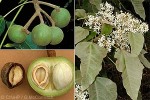Cook Islands Biodiversity Database
Species Page
Aleurites moluccana
TuituiCandlenut
Multimedia & Additional Resources
| Type | Description | Download |
| Flowers, fruit and young leaves | 64KB |
General Information
Cook Islands Distribution
| Southern Group: Present Makatea: Present | ||||||||
RR |
MG |
AT |
MK |
MT |
AK |
PL |
TK |
MN |
++++ |
++++ |
++++ |
++ |
+++ |
+ |
- |
- |
|
| Northern Group: | |||||
TN |
MH |
RK |
PK |
NS |
SW |
- |
- |
- |
- |
- |
- |
Scientific Taxonomy
Aleurites moluccana Linnaeus
SYNONYMS: Acalypha triloba; Jatropha moluccana
TAXONOMY: PLANTAE; ANTHOPHYTA (=Angiospermae); MAGNOLIOPSIDA (=Dicotyledones); ROSIDAE; Euphorbiales; EUPHORBIACEAE
More Information
SIGNIFICANCE NOTES -. Comment: NBSAP - Aitutaki (5 of 5 wild plants)
POSITIVE SIGNIFICANCE: Medicine, Food (former SD), Material (Light), Adornment.. Comments: In former times the oily nuts were threaded onto thin skewers and burnt for light. The soot from the burnt nuts was used formerly also in tattooing. The nuts were noted as a food source at times, especially during famine. The oil from the nut was used as a wood polish. Seeds were used as part of a concoction for treating ear- and headaches. A dye, called ‘iri was made from the inner bark and used to stain tapa cloth. (Whistler 1990). The cooked kernel of the seed is harmless, but when eaten raw it can cause violent vomiting and purging (Arnold 1968).The seeds are made into jewellery, and oil is extracted and made into varnish for lamps (Graf 1992). The Candlenut is highly esteemed in Hawai'in society for its multiplicity of uses, including those mentioned above, and more including those relating to the wood and bark (Neal 1965).
NEGATIVE SIGNIFICANCE: Invasive - moderate; Poisonous raw seed - moderate
Vouchers & References
Vouchers:
None Recorded.
References:
p.598 Wagner et al.- Flowering Plants of Hawaii
p.505 Neal - In Gardens of Hawaii
p.42 Royal Hort. Soc. Index of Garden Plants
p.407 Tropica
p.2/548 A.C.Smith - Flora Vitiensis Nova
p.295 I Cheeseman - Flora of Rarotonga
p.65 Wilder - Flora of Rarotonga
p.408e Whistler - Ethnobotany of the Cook Islands
p.100 McCormack/Kunzle - Rarotonga's Mountain Tracks and Plants
Data Update History (information):
zTX, zB02, zM03a, zupM03b, zD02, zupD04b
Web Resources
Citation Information
McCormack, Gerald (2007) Cook Islands Biodiversity Database, Version 2007.2. Cook Islands Natural Heritage Trust, Rarotonga. Online at http://cookislands.bishopmuseum.org. ![]()
Please refer to our use policy.

